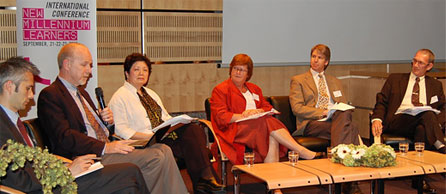
Attending the New Millennium Learners Conference in Brussels was a professional highpoint and profound experience for me. Much of what I learned confirmed understandings I have come to regarding issues in the US and Australia, but hearing them voiced in an international context – and with data-backed evidence – prompts me to post highlights from the sessions. Please understand that these are my impressions and interpretations, not an unbiased or comprehensive digest of the proceedings. Here is a press release for the conference that provides a good overview.
I only meant this post to be a quick conference de-brief, but my interest has expanded it into a fairly major piece of writing and analysis. Apologies to my colleagues whose presentations receive only light treatment when they actually represent deep bodies of work and years of effort. Thanks to Jan Craemer and those who organized the sessions and Web site – your insightful ordering of the days’ topics and presenters emerged as I looked closer. For those who did not attend, I post this to invite your discussion and participation in an initiative that I believe will contribute to education’s evolution to something better.
Day 1 Focus: “New Millennium Learners”
Dr Barbara Ischinger, who is the Director for Education for the OECD, began the discussion on New Millennium Learners by focusing on a historical review of how education has seen its role in relation to goals and expectation for technology. This set a context for where we are now, this far into the 21st Century. Especially useful are four points that offer a new framework to focus current debate:
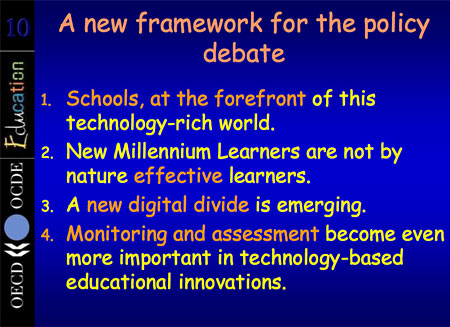
Of the four points, I believe that the first is an aspiration based on significant case studies (see day three) and recognition that not to be at the forefront of our cultures’ learning resources relegates this institution to history. The second point is a clear observation of what has been too-long obscured by educational marveling at what can be achieved through expert use of current technologies coupled with children’s quick adoption of gadgets and lifestyle software. It’s been my contention (as argued in 2005’s New WWW article for Educational Leadership), that these technologies ensure access to “Whatever, Whenever, Wherever” but not, necessarily, amazing learning experiences. The third point identifies a key finding of the New Millennium Learners project that will be discussed in the next section while the fourth point draws attention to an area that is in its infancy but holds great promise and was mentioned by a number of speakers at the conference. Dr Ischinger’s presentation can be accessed in full as a pdf from the NML Conference Web site.
Andreas Schleicher presented the conference’s first keynote and laid out a persuasive case for why education needs to respond technology-induced changes. One key point was that the goal of Industrial Age learning was to instill discipline so that students could become workers prepared to fill the defined roles and limited tasks required by of mass production. Today’s learners must be “goal-motivated.” Of six characteristics presented by Mr. Schleicher, one that I found particularly insightful was his statement that New Millennium Learners must be “Great Versitalists” – those who possess a depth of skills (and knowledge) so that they can apply their learning to new situations. This process of continuous learning speaks to the adaptability and innovation that is required by an age of rapid change and unknown conditions. Mr. Schleicher cited the work of Levy and Murnane and shared this compelling graph.
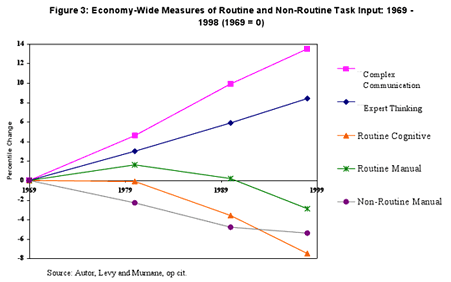 As Schleicher emphasized, the skills that are easiest to teach and test are also the ones that are easiest to digitise, automate and outsource. Governments, departments of education, universities and schools that continue to educate for an Industrial Age must be pushed by data such as this to justify their positions. You can download a pdf of Mr. Schleicher’s presentation from the NML conference Web site.
As Schleicher emphasized, the skills that are easiest to teach and test are also the ones that are easiest to digitise, automate and outsource. Governments, departments of education, universities and schools that continue to educate for an Industrial Age must be pushed by data such as this to justify their positions. You can download a pdf of Mr. Schleicher’s presentation from the NML conference Web site.
 Francesc Pedró, principal administrator of the New Millennium Learners project at the OECD, presented the preliminary findings based on existing empirical evidence. Because this is the central document of the conference, rather than discuss Dr Pedró’s presentation, I’d like to focus on the document itself. Perhaps this will prompt colleagues currently not in the NML process to analyze the findings and to join the discussion. Furthermore, my hope is that through this post and ongoing updates, decision-makers in education may make choices based on genuine evidence, not popular myths, about today’s learners. In the words of Andreas Schleicher’s last slide, “without data, you’re just another person with an opinion.” Although we’ve yet to “plug the data drain,” rich and granular information will be the driver of the next model for education in our digital age. So, onto my analysis of the findings…
Francesc Pedró, principal administrator of the New Millennium Learners project at the OECD, presented the preliminary findings based on existing empirical evidence. Because this is the central document of the conference, rather than discuss Dr Pedró’s presentation, I’d like to focus on the document itself. Perhaps this will prompt colleagues currently not in the NML process to analyze the findings and to join the discussion. Furthermore, my hope is that through this post and ongoing updates, decision-makers in education may make choices based on genuine evidence, not popular myths, about today’s learners. In the words of Andreas Schleicher’s last slide, “without data, you’re just another person with an opinion.” Although we’ve yet to “plug the data drain,” rich and granular information will be the driver of the next model for education in our digital age. So, onto my analysis of the findings…
Core Findings about “NMLs”
“A” New Millennium Learner doesn’t exist
Quoting from the document:
[I]irrespective of how attractive the label of NML may be, it should by no means be used to describe a generation-wide phenomenon because the effects of digital technologies on learners are deeply influenced by factors such as age, gender, and socioeconomic status. Therefore, the generational approach adopted by most analysts and essay writers cannot be sustained empirically.
If nothing else makes it through the whitenoise to the popular press and consciousness, this finding should be it. We are past the days where blanket generalizations are useful. The reason for this resides in the technology itself: by nature digitalization enables access to an increasingly infinite range of rich media experiences. These are not fixed by time, location, gadget or age. Instead, the technologies challenge the Industrial Age mentality that sees things as standardized outcomes – almost as if they were produced by an assembly line itself. Constructs such as “Digital Natives,” “Millennials” and “Gen Y” may initially challenge preconceived expectations to see the relationship between technology and youth in new ways, but they soon become used as standardized boxes into which we group huge populations of unique people. It will take time for this simplistic assembly line thinking to transform into other ways of seeing, but the NML research should be a positive effort in this direction.
I can see that this analysis is fairly abstract, so let me offer a concrete example. An illustration of “assembly line thinking” is the tendency to make simplistic conclusions after adding together a few bits: we see some teenagers create amazing digital movies, others touch type quickly on a phone keypad, or still others speed through video games and we assume “teenagers are good with technology.” The assembly line and mass production are powerful metaphors, but they assume a linear model of “this + this + these = THIS, now multiply it many many times.” I suggest that a more appropriate metaphor emerges through the technology itself. For example, “based upon Web search histories, online purchases and user-defined preference profiles, others who share many of these data points also watched these movies, played World of Warcraft to this level and sent this range of text messages.” Companies at the forefront of mobile commerce already mine such data to target specific messages to smaller segments of their markets. So instead of mass production, the technology enables what Alvin Toffler called “mass customization” or “demassification.” Of course this is the heart of calls for education to focus on “personal learning,” but we will have to avoid the temptations of our conditioning to see even personal learning as “an” approach or strategy that operates from a “one-size-fits-all” orientation rather than the more sophisticated arrangement of “if-thens” that portray a more nuanced and informative representation.
New Digital Divides
The NML report sounds this caution itself, warning that the case for the New Millennium Learner might obstruct “the required policy focus on how different might be the effects of technologies on different profiles of young people and how urgent is to develop adequate policy strategies to cope with the emerging divides.” Of the potential divides, two in particular receive analysis in the report. First, OECD and Pew data highlight different patterns of use between genders where,
- “Boys use computers and the Internet more than girls, have wider computer experience, spend more time online, report greater interest in and perceive more positive attitudes to computer-related activities, boys also appear to be more motivated to learn digital skills”
- “girls seem to be dominating in the communicative field of ICT, like word processing, text messaging on cell phone, as well as e-mail and blogging”
As identified in the report, a bias toward the more diverse and vocal ICT-using gender could define the “knowledge society” paradigm as a predominantly male domain, especially with lower numbers of women entering “ICT related professions.” To its credit the NML Project team is organizing an expert meeting to “disentangle the gender issue in this domain, and whether targeted educational policies and practices have to be put in place” so policies can ensure that females are not disadvantaged.
The second newly verified digital divide emerges as an amplification of differences in socioeconomic status. You might think the divide comes as a result of access: the “Haves” and the “Have-Nots.” In fact, reliable projections from ongoing surveys suggest that from 2009 on “frequent use of a computer at home will become a universal feature of young people aged 15 in most OECD countries.” As might becoming obvious, the issues are more finely grained. Thus the emerging socioeconomic divide is not about “access, but about differences in use.” The NML report labels this as a “Matthew effect” because it’s analogous to the “rich get rich, poor get poorer” observation in the Gospel of Matthew. Dr. Pedró’s presentation (pdf) illustrates this point in a slide that shows a rise in performance for higher SES technology-using students over their peers after SES is factored.
… from the existing limited evidence it emerges very clearly that, for instance, the uses of the Internet, particularly the balance between leisure-oriented and learning-oriented activities, strongly depend on a number of family variables such as parents’ educational level, experience and frequency of Internet use, which are in turn extremely connected to their socio- economic status (Mominó, 2008). Family’s cultural capital is undoubtedly reflected also in parents’ Internet practices and therefore influences as well children’s and youngsters’ approaches to technologies (Pasquier, 2007).
Happily, as Dr Pedró stated, the “poor get poorer” aspect was not observed in the data, but the increase for higher SES learners warrants “a new set of educational policies and practices, as it is related to technology practices associated to cultural capital.”
Subsequent sections of the NML Preliminary Findings 2009 examine research in two other broad areas: “the effects of technologies on learners” and “technology and educational performance.” Although some evidence exists, I believe that one of the report’s greatest contributions is that it “unveils how little is known” in the “controversial areas such as the effects of technologies on cognitive skills development, social values and lifestyles, and educational performance.” After several decades of visionary claims for technology’s impact on education, it’s significant – and inspiring – that such a collection of global educational leaders have come to the point where real learning begins: we don’t know, but we need to find out.
Highlights from the Conference
In the interest of getting this refection into the press while also sharing the significant work of international colleagues, the remainder of this post will briefly share things you won’t want to miss. Fortunately the Flemish ministry of education has done a great job making keynotes and documents available from the NML conference Web site, so explore the links, feel free to enter the discussion and spread the word.
Prof. dr. Jos De Mul presented the second keynote entitled “Multitaskers: Information hunters in the newest stone age.” You can download a pdf of the slides or listen to the presentation itself.
Listen to Professor De Mul’s Keynote: [podcast]https://www.nml-conference.be/wp-content/uploads/2009/09/day2.mp3[/podcast]
Professor De Mul’s analysis of multitasking is a good example of going beyond reverence for youthful connectedness toward a considered appraisal of this strategy for coping with information overload. Rather than marvel at or dismiss the approach, we learn about its subtleties: that genders respond differently to information overload; the truth about serial processing versus multitasking; and the inefficiency of “semi-multitasking” for cognitive storage of information.
The following sessions surveyed different government policies on fostering 21st century competencies. OECD analysts Magdalena Claro and Katerina Ananiadou made the initial presentation (pdf) summarizing data collected from the country survey. Something that many jurisdictions will find useful is their attempt to clarify terminology. The survey highlighted that many countries have hazy definitions that are more a wish list than policy guidelines. Researchers Claro and Ananiandou offered distinctions among ICT Functional Skills (ECDL/ICDL), ICT Skills for Learning (ISTE’s NETS) and 21st Century Skills and Competencies (ATC21S.org). I was pleased that all presenters and discussants at the conference focused on the latter approach which is comprehensive of the others but places primary emphasis on the cognitive and character qualities that, when developed, allow people to take greatest advantage of ICTs.
A series of experts then shared feedback to the data on fostering 21st Century competencies. A slide from Marc Durando of the European Schoolnet succinctly captures the inhibitors to implementing such policies and programs. I see each inhibitor as an invitation to each member of our profession to contribute their insights and efforts to supporting the change and, ultimately, transformation of one system of education to a new model for this century. Many of the speakers at the conference were doing just this, so looking to their work through these links and beyond might be paths to joining the effort.
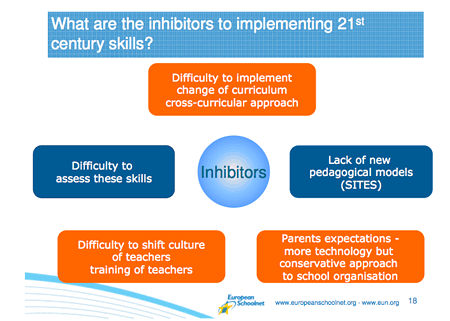
Martin Ripley, speaking for the Assessment branch of the atc21s.org, began the discussion, sharing his group’s perspective.
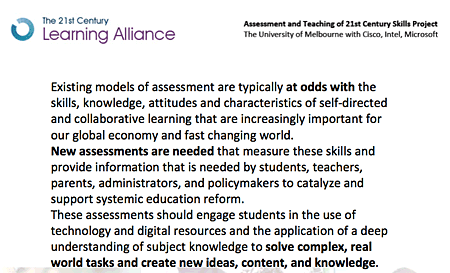
It’s important to remember that this statement comes from the powerful partnership of high tech companies and Barry McGaw’s leadership based at Melbourne University. This is an influential alliance so such a focus on authentic learning should be seen as recognition that “technology” is not the solution, but part of a comprehensive new model. I spoke briefly with Martin Ripley and was impressed by the data that is currently being collected through students’ online behaviors as well as how it is presented to support more detailed insights into learners’ performances. As noted this is sure to be a hallmark of any new model for “schooling” and I was impressed and reassured that such a commanding team was sincerely struggling with approaches that help individualize learning through authentic challenges. In fact, the last line in the above slide could be taken from any work that I have done on WebQuests so it’s not difficult to understand why I am excited by this group’s potential contribution. You can read more about all the working groups at the ATC21S.org Web site.
For those colleagues working at the government / ministry levels and looking for input from a nation that has been very successful in raising education performance, the “Road Ahead” provided by Oystein Johannessen could be useful. Mr Johannessen is the Deputy Director General from the Norwegian Ministry of Education and Research about to begin a secondment to the OECD’s Centre for Educational Research and Innovation (CERI).
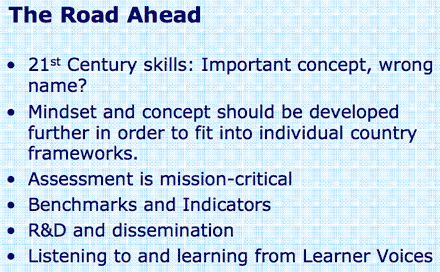
Like Mr. Johannessen, I tend to think there may be more appropriate terms than “21st Century Skills.” My reasons are 1) we are already 1/10 of the way into the century and see little change in school practice which might suggest to reluctant colleagues that maybe things will be okay just as they always have been; 2) “21st Century” had a ring of the new and unknown back in the 1990s, but like all such terms has acquired baggage and misunderstanding (many people understand this to mean ICT functional skills, not the more challenging thinking and character traits). I often adopt MCEETYA’s phrase “Contemporary Learning” to highlight that these more authentic approaches need to become “everyday / just the way we learn,” but have come to settle on “Digital Learning Skills” as most appropriate and communicative. Digitization encompasses computers, mobile devices, connectivity, media, personal data mining, Web services, collaboration tools, online and virtual environments, etc. all of which can enrich learning. I realize that organizations already have commitments to their own phrases for our era’s new learning requirements, so the main task is the one the NML project and conference has initiated: detailing what this looks like and fitting into policy and curriculum. Norway demonstrated its leadership early on by identifying “Digital Skills” as among the five basic skills (along with reading, writing, numeracy and oral skills).
The last sessions for Day Two were a series of country case studies that demonstrated how some jurisdictions are pursuing this challenge and making steps along the road ahead. Dr. David Preiss and Magdalena Claro, from Chile’s CEPPE shared a recent national assessment of students’ ICT Skills for Learning. The process is just beginning on a national scale, but the drive to make the tasks authentic was again apparent:
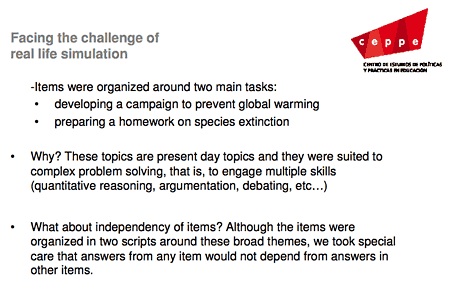 For me this confirms what has been apparent over the last decade regarding WebQuests, they remain a solid framework for scaffolding such authentic learning, but understanding the difference between knowledge acquisition and construction of meaning is one of the greatest blockers for our current workforce. Thus the task remains to keep highlighting examples of student learning that go beyond traditional approaches and embrace student-managed learning and real world challenges.
For me this confirms what has been apparent over the last decade regarding WebQuests, they remain a solid framework for scaffolding such authentic learning, but understanding the difference between knowledge acquisition and construction of meaning is one of the greatest blockers for our current workforce. Thus the task remains to keep highlighting examples of student learning that go beyond traditional approaches and embrace student-managed learning and real world challenges.
Another country whose student performance has risen dramatically over the past two decades is that of South Korea. Prof. Heeok Heo, Sunchon National University and Jeonghee Seo, Korean Education Research and Information Service shared their thoughtful and comprehensive approach to a conceptual framework.
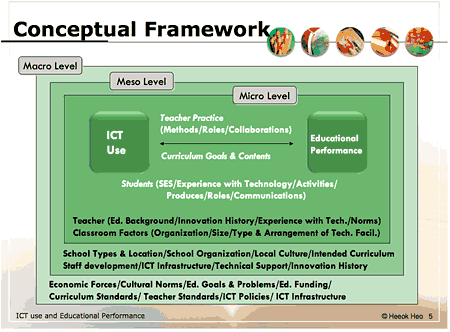
(Click on the slide to view a larger version)
This thorough identification of the components involved in truly measuring the impact of ICT use on students’ educational performance could be a model for all nations. The next issue becomes the disciplined pursuit of articulation and implementation across all levels. Here is where many jurisdictions become “unstuck.” Superficial analyses and politically, rather than pedagogically, motivated decisions are often made that often run counter to empirical evidence. Part of the reason for this can be found in Marc Durando’s earlier presentation showing parents’ expectations for more technology in schools, but also more conservation approaches to school organization and curriculum. Sometimes what’s needed is a new way of seeing the situation. Prof. Heeok also shared a powerfully synthetic model that could help in this area. Rather than see “school” or “education” or “learning,” she and her colleague from South Korea offered a compelling, multi-dimensional model:
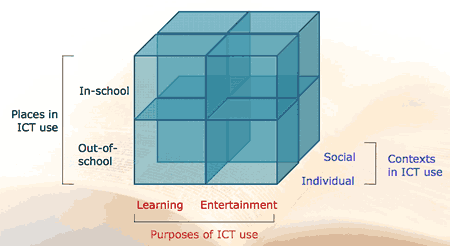 Identifying the places, purposes and contexts of ICT use in this way sets a more sophisticated framework for eventual data collection and subsequent policy decisions. I suppose this is why I found the whole NML / OECD experience so inspiring: here were global leaders in education focused on discovering the truth about learning and education in our era, not maintaining the status quo or finding easy and insufficient answers. This combined with the belief that the OECD and partners such as the ATC21S alliance are potent agencies for change. Watch this work over the coming years and demand data-based decision making from your local authorities.
Identifying the places, purposes and contexts of ICT use in this way sets a more sophisticated framework for eventual data collection and subsequent policy decisions. I suppose this is why I found the whole NML / OECD experience so inspiring: here were global leaders in education focused on discovering the truth about learning and education in our era, not maintaining the status quo or finding easy and insufficient answers. This combined with the belief that the OECD and partners such as the ATC21S alliance are potent agencies for change. Watch this work over the coming years and demand data-based decision making from your local authorities.
As the last case study Paula Christophersen of the Victorian Curriculum and Assessment Authority presented a combined Victorian and Federal perspective as Australia moves to a national curriculum. Mrs. Christophersen concisely framed current developments in a historical context ending with the recent Education Revolution initiatives.
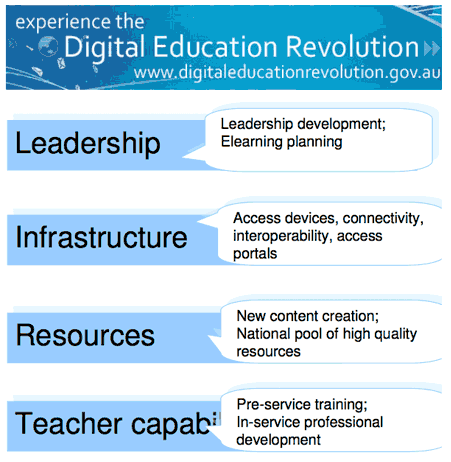 Perhaps I am a little jaded having more local insight on the Australian story than that of other countries, but I have some skepticism around whether the visionary statements of the MCEETYA Contemporary Learning documents and the Melbourne Declaration will be embodied in the details of a National Curriculum. Certainly the resources and intentions are in place for the first time in recent memory, and perhaps the onus is on those of us viewing events from the sidelines to take an active role in publicizing successful strategies. I detected a level of weariness and frustration in my own and colleagues presentations at this year’s NECC conference in Washington D.C. After two decades of working to transform education through smart use of ICTs and seeing little change, it’s easy to lose momentum – yet the larger pieces are now falling into place (access, bandwidth, interfaces, etc.) so that the next ten years is critical. Mrs. Christophersen’s presentation highlighted the momentousness of this point in our journey.
Perhaps I am a little jaded having more local insight on the Australian story than that of other countries, but I have some skepticism around whether the visionary statements of the MCEETYA Contemporary Learning documents and the Melbourne Declaration will be embodied in the details of a National Curriculum. Certainly the resources and intentions are in place for the first time in recent memory, and perhaps the onus is on those of us viewing events from the sidelines to take an active role in publicizing successful strategies. I detected a level of weariness and frustration in my own and colleagues presentations at this year’s NECC conference in Washington D.C. After two decades of working to transform education through smart use of ICTs and seeing little change, it’s easy to lose momentum – yet the larger pieces are now falling into place (access, bandwidth, interfaces, etc.) so that the next ten years is critical. Mrs. Christophersen’s presentation highlighted the momentousness of this point in our journey.
To fill in the complete picture two final presentations concluded Day Two and offered perspectives from industry and social partners. Charles Fadel, of Cisco, began and provided a very informative overview of the leadership contributed through the Partnership for 21st Century Skills, of which he is a committee co-chair. The Partnership’s achievements in the US have been substantial over many years. Their model is useful for conceptualizing 21st Century Outcomes and support systems.
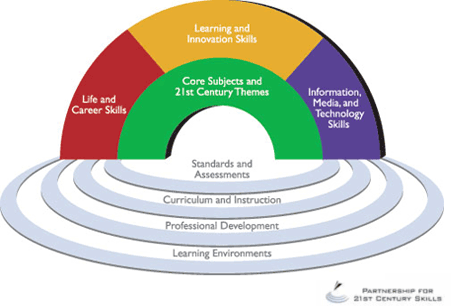
The articulated themes that, along with the core academic subjects, span the more specific 21st Century skills (in red, gold and purple) offer “real world” applications that teachers and curriculum specialists can use to strengthen the relevance of their current syllabi.
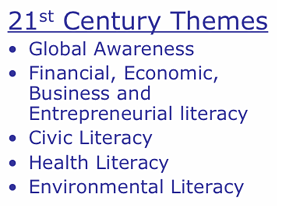
Roland Schneider, represented the Trade Union Advisory Committee of the OECD, voicing concerns for workers caught in the middle of our era’s social and economic changes. With reason, he questioned whether there is in fact “a rising demand for knowledge workers or increasing polarisation?” One slide illustrated the point by focusing on the jobs with the highest growth rate in 2006 US data:
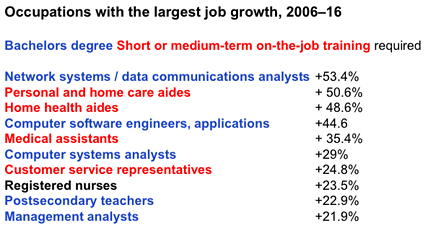 Those in red only require on-the-job training compared to those in blue that require a university degree. Furthermore, drawing from the same data, Mr. Schneider pointed out that less than 9% of all occupations require more than a bachelor’s degree. This perspective is important to keep in mind because it’s easy to see “21st Century” and think “High Tech.” Anyone who has been in the workforce over the past three decades is well aware of massive job cuts in many engineering, telecommunications and middle management positions. All I need is to remember that these tens of thousands of lay-offs were first called “downsizing” and then even more euphemistically termed “right-sizing” to feel that education’s calling is more important than industry calls to fill skills shortages: our children’s lives and welfare take a higher priority. Mr. Schneider offered a solution that fits better with our Digital Era than the one-size-fits all demands of a mass production mindset: “facilitate the creation of skill ecosystems, bring governments, key stakeholders and business representatives together to look more closely on changes necessary in order to address the challenges faced.” This again draws attention to the consensus among participants at the NML Conference that “21st Century Skills” have more to do with critical thinking and creative problem-solving in an ever changing world than simply computer literacy or job preparation.
Those in red only require on-the-job training compared to those in blue that require a university degree. Furthermore, drawing from the same data, Mr. Schneider pointed out that less than 9% of all occupations require more than a bachelor’s degree. This perspective is important to keep in mind because it’s easy to see “21st Century” and think “High Tech.” Anyone who has been in the workforce over the past three decades is well aware of massive job cuts in many engineering, telecommunications and middle management positions. All I need is to remember that these tens of thousands of lay-offs were first called “downsizing” and then even more euphemistically termed “right-sizing” to feel that education’s calling is more important than industry calls to fill skills shortages: our children’s lives and welfare take a higher priority. Mr. Schneider offered a solution that fits better with our Digital Era than the one-size-fits all demands of a mass production mindset: “facilitate the creation of skill ecosystems, bring governments, key stakeholders and business representatives together to look more closely on changes necessary in order to address the challenges faced.” This again draws attention to the consensus among participants at the NML Conference that “21st Century Skills” have more to do with critical thinking and creative problem-solving in an ever changing world than simply computer literacy or job preparation.
“New ways of assessing 21st century skills”
Day Three focused attention on the crucial question of how to assess learning and achievement. Dr. Robert Kozma began the discussion by presenting the keynote below.
Dr. Robert Kozma – Toward the Assessment of 21st Century Skills
[podcast]https://www.nml-conference.be/wp-content/uploads/2009/09/Nummer.mp3[/podcast]
Dr. Kozma serves as a consultant to the ATC21S.org project. His involvement – as well as that of the previous speakers – provided further evidence that the initiative directed by Professor Barry McGaw could have profoundly positive results for education. The presentation began with the observation that “Assessments hold systems accountable. At the same time they are a gate to any systemic change in education.” Dr. Kozma continued to outline the structure and timelines for the project, specifically focusing on the five working groups:
- 21st Century Skills
- Methodological Issues
- Technological Issues
- Classroom Learning Environments and Formative Evaluation
- Policy Frameworks for New Assessments
Each group is headed by what could be mistaken as a “Who’s Who” in the field of educational research and technology. More information about the groups is available from the Web site as well as a form to express your interest in getting involved.
My favorite project presented at the conference was that by Estela Souza, of the Lumiar Institute, Brasil / London. Ms. Souza described how Lumiar and its partners “built a school from scratch.” Significantly, this effort began with a challenge that whose who know me can predict that I would respond to:

This was the challenge posed in 2002 to 20 cross-sector thinkers and developers. They came up with this vision:
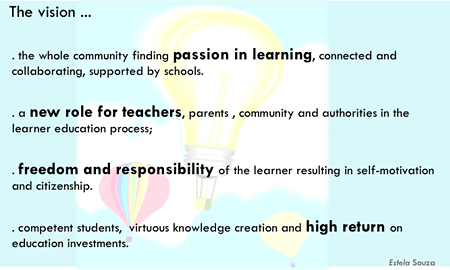 I have to fight the temptation to share the whole of Ms. Souza’s presentation so instead will focus on two main aspects and provide a link to the Lumiar Institute. First, this is a real project – meaning education connected with a community and built a school:
I have to fight the temptation to share the whole of Ms. Souza’s presentation so instead will focus on two main aspects and provide a link to the Lumiar Institute. First, this is a real project – meaning education connected with a community and built a school:
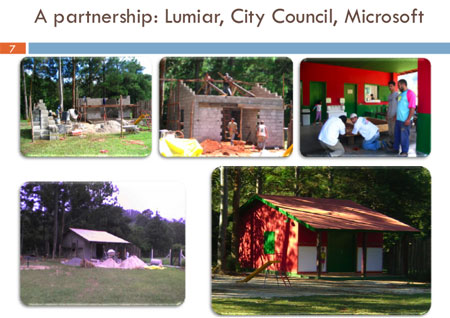 The authenticity of the physical building is mirrored in the group’s adherence to its vision of a learner-initiated curriculum. Projects emerged from student interests and issues. Teacher / moderators helped to embed content and skills into the authentic task. Many of us have argued for years that this approach works well, but the Lumiar Institute has gone a step farther and created a software system called Mosaic that maps identified and achieved learning onto a matrix of tiles:
The authenticity of the physical building is mirrored in the group’s adherence to its vision of a learner-initiated curriculum. Projects emerged from student interests and issues. Teacher / moderators helped to embed content and skills into the authentic task. Many of us have argued for years that this approach works well, but the Lumiar Institute has gone a step farther and created a software system called Mosaic that maps identified and achieved learning onto a matrix of tiles:
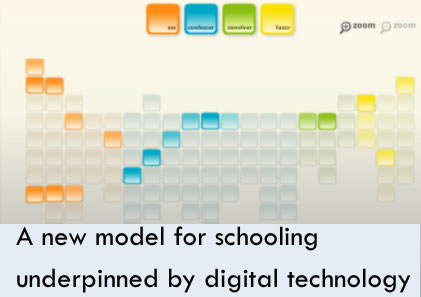
Each tile represents the student’s progress. I look forward to learning more about Mosaic and how it might evolve.
Steen Lassen, an adviser to the Danish Ministry of Education, presented the next case study on assessment in the Digital Age. Coming, as I do, from a state that typically bans technology and insists that Year 12 cumulative exams be handwritten, it was eye-opening to see that as of 2000 over 98% of Danish students used a computer on their written examination. As amazing as this student use is, overall integration of ICT in the senior secondary sector is a model for all government educational systems:
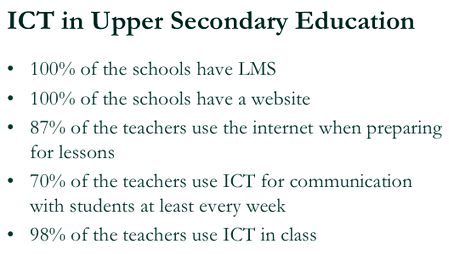
Not content to rest as a leader, Denmark is on the verge of conducting exams that include student access to the Internet. Another example of innovation that would send other systems into educational “turf wars” is that cross-curricular exams are used to account for multiple content areas. Without knowing the inner workings of what has empowered this E-assessment policy & practice in Danish secondary schools, one thing is clear: while some some countries have spent the last ten years squabbling about why these changes aren’t possible, Denmark has made the innovations work. I will certainly watch the Danish Ministry of Education’s next evolutions with interest.
The last view on assessment was presented by Serge Ravet, of the European Institute for E-Learning, on using E-portfolio for e-assessment. Going back over almost two decades, Mr. Ravet began by reaffirming the portfolio’s place as a persuasive tool for authentic assessment: “a portfolio is opinion backed by fact…Students prove what they know with samples of their work.” Through an artful and informative presentation Mr Ravet compared and contrasted related aspects of assessment. One such example – and worthy of everyone’s reconsideration who has been “doing portfolios” for years is this particular slide:
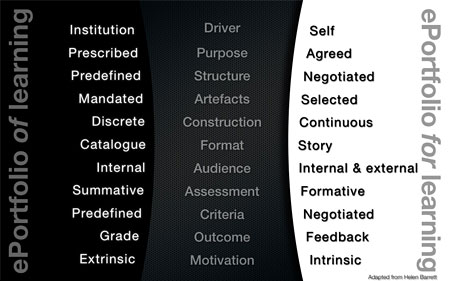
We often lose the spirit behind educational innovations and turn them into mind-numbing routines. Contrasting what might be considered “assigned” portfolios to those student use to drive their own learning is a step toward reinvigorating the approach through revisiting our professional practice.
Closing Session
The closing session began with a masterful summary from conference rapporteur Anthony Mackay. His conference report is a salient synthesis of all the presentations into eight Key Messages of the New Millennium Learners conference:
- Governments are listening … and acting
- 21st century competencies … the connecting thread and the main game.
- The 21st century digital learner is increasingly driving the agenda … and demanding a 21st century skill set for life and work
- Stay focussed on the big goal and the imperative of implementation.
- This is a transformation agenda – beyond improvement.
- New Millennium Learning is a collective responsibility.
- Invest in educators and innovative learning environments.
- Moving from a transformed education system to a learning society
These messages demonstrate that change is happening and where individuals and organizations can make contributions. Against this backdrop of concerted effort and interest, it took Dirk Van Damme, the Head of the OECD’s Centre for Education Research and Innovation to (CERI), to mention the Global Financial Crisis. This ongoing event highlights the need to prepare students for an unknown future where the only certainty is change and the most successful people will be able to analyze what’s happening and to make choices that support their own and their community’s welfare. This brings to clear focus the difference between ICT Literacy / “High Tech job prep” and 21st Century Skills.
My Conclusions
Perhaps the main message is that as a field we are beyond the point of “this or that,” “black or white,” “Good or Bad.” It’s no longer “access to computers or not,” “Young users versus old,” or “Computer use means… gaming, blogging, social networking, instant messaging, cyberbullying, etc.” We are at the beginning of early maturity in the profession. I invite and challenge my colleagues who speak out about issues in educational technology to recognize this and to shift from offering “insights” to data-backed examples, so that we may ultimately develop testable models for specific diagnosis of learning situations that begin with profiles of learners and their given contexts.
Since the beginning WebQuests have been a hypothesis based on an integration of research-based approaches like motivation theory, constructivism and critical thinking. The variables involved in testing the model approach the infinite when you consider things like access to computers, speed of networks, classroom culture, attitudes toward technology, prior experience with inquiry learning, levels of cognitive scaffolding, etc. However, now that the initial hurdles of access and bandwidth are surmounted by large populations and data collection is on the agenda as it relates to authentic passive assessment of users’ online behaviors, real work can begin. The question is no longer the unanswerable, “Do WebQuests (or technology-use itself) produce better learning outcomes?” Finally we can begin to investigate the more testable “if-thens” of context and application because we have large online sample sizes and increasingly sophisticated data analysis. If Google can analyze each simple search using 200 signals from a database algorithm “considering more than 500 million variables and 2 billion terms,” imagine what we could learn from even one percent of this power of analysis and learner profiling?
“One-size-fits-all” is over. The current reality is more akin to “All-fit-to-one’s-size”.
You can access the post from: https://tinyurl.com/ykc5c24
Like this:
Like Loading...




 As Schleicher emphasized, the skills that are easiest to teach and test are also the ones that are easiest to digitise, automate and outsource. Governments, departments of education, universities and schools that continue to educate for an Industrial Age must be pushed by data such as this to justify their positions. You can
As Schleicher emphasized, the skills that are easiest to teach and test are also the ones that are easiest to digitise, automate and outsource. Governments, departments of education, universities and schools that continue to educate for an Industrial Age must be pushed by data such as this to justify their positions. You can 



 For me this confirms what has been apparent over the last decade regarding WebQuests, they remain a solid framework for scaffolding such authentic learning, but understanding the difference between knowledge acquisition and construction of meaning is one of the greatest blockers for our current workforce. Thus the task remains to keep highlighting examples of student learning that go beyond traditional approaches and embrace student-managed learning and real world challenges.
For me this confirms what has been apparent over the last decade regarding WebQuests, they remain a solid framework for scaffolding such authentic learning, but understanding the difference between knowledge acquisition and construction of meaning is one of the greatest blockers for our current workforce. Thus the task remains to keep highlighting examples of student learning that go beyond traditional approaches and embrace student-managed learning and real world challenges.

 Perhaps I am a little jaded having more local insight on the Australian story than that of other countries, but I have some skepticism around whether the visionary statements of the MCEETYA Contemporary Learning documents and the Melbourne Declaration will be embodied in the details of a National Curriculum. Certainly the resources and intentions are in place for the first time in recent memory, and perhaps the onus is on those of us viewing events from the sidelines to take an active role in publicizing successful strategies. I detected a level of weariness and frustration in my own and colleagues presentations at this year’s NECC conference in Washington D.C. After two decades of working to transform education through smart use of ICTs and seeing little change, it’s easy to lose momentum – yet the larger pieces are now falling into place (access, bandwidth, interfaces, etc.) so that the next ten years is critical. Mrs. Christophersen’s presentation highlighted the momentousness of this point in our journey.
Perhaps I am a little jaded having more local insight on the Australian story than that of other countries, but I have some skepticism around whether the visionary statements of the MCEETYA Contemporary Learning documents and the Melbourne Declaration will be embodied in the details of a National Curriculum. Certainly the resources and intentions are in place for the first time in recent memory, and perhaps the onus is on those of us viewing events from the sidelines to take an active role in publicizing successful strategies. I detected a level of weariness and frustration in my own and colleagues presentations at this year’s NECC conference in Washington D.C. After two decades of working to transform education through smart use of ICTs and seeing little change, it’s easy to lose momentum – yet the larger pieces are now falling into place (access, bandwidth, interfaces, etc.) so that the next ten years is critical. Mrs. Christophersen’s presentation highlighted the momentousness of this point in our journey.

 Those in red only require on-the-job training compared to those in blue that require a university degree. Furthermore, drawing from the same data, Mr. Schneider pointed out that less than 9% of all occupations require more than a bachelor’s degree. This perspective is important to keep in mind because it’s easy to see “21st Century” and think “High Tech.” Anyone who has been in the workforce over the past three decades is well aware of massive job cuts in many engineering, telecommunications and middle management positions. All I need is to remember that these tens of thousands of lay-offs were first called “downsizing” and then even more euphemistically termed “right-sizing” to feel that education’s calling is more important than industry calls to fill skills shortages: our children’s lives and welfare take a higher priority. Mr. Schneider offered a solution that fits better with our Digital Era than the one-size-fits all demands of a mass production mindset: “facilitate the creation of skill ecosystems, bring governments, key stakeholders and business representatives together to look more closely on changes necessary in order to address the challenges faced.” This again draws attention to the consensus among participants at the NML Conference that “21st Century Skills” have more to do with critical thinking and creative problem-solving in an ever changing world than simply computer literacy or job preparation.
Those in red only require on-the-job training compared to those in blue that require a university degree. Furthermore, drawing from the same data, Mr. Schneider pointed out that less than 9% of all occupations require more than a bachelor’s degree. This perspective is important to keep in mind because it’s easy to see “21st Century” and think “High Tech.” Anyone who has been in the workforce over the past three decades is well aware of massive job cuts in many engineering, telecommunications and middle management positions. All I need is to remember that these tens of thousands of lay-offs were first called “downsizing” and then even more euphemistically termed “right-sizing” to feel that education’s calling is more important than industry calls to fill skills shortages: our children’s lives and welfare take a higher priority. Mr. Schneider offered a solution that fits better with our Digital Era than the one-size-fits all demands of a mass production mindset: “facilitate the creation of skill ecosystems, bring governments, key stakeholders and business representatives together to look more closely on changes necessary in order to address the challenges faced.” This again draws attention to the consensus among participants at the NML Conference that “21st Century Skills” have more to do with critical thinking and creative problem-solving in an ever changing world than simply computer literacy or job preparation.
 I have to fight the temptation to share the whole of Ms. Souza’s presentation so instead will focus on two main aspects and provide a link to the
I have to fight the temptation to share the whole of Ms. Souza’s presentation so instead will focus on two main aspects and provide a link to the  The authenticity of the physical building is mirrored in the group’s adherence to its vision of a learner-initiated curriculum. Projects emerged from student interests and issues. Teacher / moderators helped to embed content and skills into the authentic task. Many of us have argued for years that this approach works well, but the Lumiar Institute has gone a step farther and created a software system called Mosaic that maps identified and achieved learning onto a matrix of tiles:
The authenticity of the physical building is mirrored in the group’s adherence to its vision of a learner-initiated curriculum. Projects emerged from student interests and issues. Teacher / moderators helped to embed content and skills into the authentic task. Many of us have argued for years that this approach works well, but the Lumiar Institute has gone a step farther and created a software system called Mosaic that maps identified and achieved learning onto a matrix of tiles:



